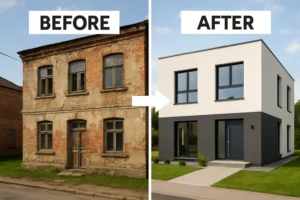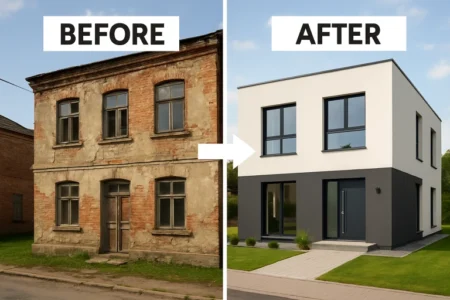In a rapidly changing world, where urban development and modern architectural design often take center stage, the preservation of cultural heritage becomes increasingly crucial. This blog post delves into the intricate realm of architectural heritage conservation, exploring its significance in maintaining cultural identity, the challenges it faces, and its role in shaping a sustainable future. Let’s embark on a journey that unravels the tapestry of our past and underscores the importance of preserving our architectural legacy for future generations.
1. The Essence of Architectural Heritage
Why is architectural heritage preservation important?
Preserving architectural heritage goes beyond safeguarding historical buildings; it is about conserving the very essence of a community’s cultural identity. These structures are not just bricks and mortar; they are living testaments to our history, reflecting the values, traditions, and architectural styles of bygone eras. Architectural heritage preservation plays a vital role in connecting the past with the present, creating a tangible link that allows us to understand and appreciate our roots.
How does architectural heritage contribute to cultural identity?
Architectural heritage is an integral part of cultural identity, serving as a visual representation of a community’s unique identity. The architectural marvels that adorn our cities tell stories of triumphs, struggles, and the evolution of societies. Through the preservation of architectural heritage, we ensure that future generations can witness and cherish the cultural diversity that defines us.
2. Challenges in Heritage Conservation
What are the challenges faced in preserving architectural heritage?
While recognizing the importance of architectural heritage conservation, it’s essential to address the challenges that hinder its effective preservation. Rapid urban development, lack of awareness, and insufficient conservation efforts pose significant threats to our cultural legacy. Striking a balance between development and heritage conservation remains a crucial challenge in ensuring that our historical buildings and urban heritage are not lost to the relentless march of progress.
How does urban development impact heritage conservation?
The dynamic nature of urban development often clashes with the static beauty of historical structures. As cities expand and modernize, historical buildings face the risk of being overshadowed or even demolished to make way for contemporary structures. Understanding and implementing conservation in urban development are vital to maintain the delicate equilibrium between progress and preserving our architectural heritage.
3. UNESCO World Heritage Sites: A Global Commitment
What is the significance of UNESCO World Heritage Sites?
UNESCO World Heritage Sites stand as beacons of global commitment to the preservation of cultural and natural treasures. These sites, recognized for their outstanding value, contribute to the collective heritage of humanity. Examining the criteria for inclusion and the role of UNESCO in preserving these sites sheds light on the international collaboration required to safeguard our world’s architectural wonders.
How does UNESCO contribute to architectural heritage conservation?
The UNESCO World Heritage designation not only honors a site’s cultural value but also brings attention to the need for conservation efforts. Through stringent guidelines and collaborative initiatives, UNESCO plays a crucial role in ensuring the protection and conservation of architectural heritage on a global scale.
4. Balancing Tradition and Modernity
Can modern architectural design coexist with heritage conservation?
The juxtaposition of modern architectural design and heritage conservation often sparks debate. However, a harmonious coexistence is possible. By integrating contemporary elements with historical structures and incorporating sustainable practices, architects can contribute to the holistic conservation of architectural heritage. Striking this balance ensures that our heritage remains relevant and adapts to the needs of the present and the future.
What role does architectural design play in heritage conservation?
Architectural design is not just about creating aesthetically pleasing structures; it is a tool for preserving and enhancing our cultural legacy. Designing with sensitivity to the historical context, using sustainable materials, and incorporating innovative conservation techniques are integral aspects of architectural design that contribute to the long-term preservation of our architectural heritage.
5. The Future of Architectural Heritage Conservation
How can we ensure the preservation of architectural heritage for future generations?
Ensuring the preservation of architectural heritage for future generations requires a multi-faceted approach. Education and awareness initiatives, community involvement, and the integration of heritage conservation into urban planning are essential components. By recognizing the value of our architectural heritage and actively participating in its preservation, we can pass on a rich cultural legacy to the generations that follow.
What is the role of cultural value in heritage conservation?
Cultural value is the heartbeat of heritage conservation. It is the intrinsic worth that a community places on its architectural heritage. Recognizing and celebrating this cultural value fosters a sense of pride and responsibility, motivating individuals and communities to actively engage in the preservation of their architectural legacy.
Conclusion: A Call to Preserve
In conclusion, the preservation of architectural heritage is not a mere endeavor to save buildings; it is a commitment to safeguarding the cultural identity that shapes us. The challenges are substantial, but the rewards—preserving cultural heritage for future generations—are immeasurable. As we navigate the complexities of urban development and architectural design, let us remember that the architectural heritage we preserve today will echo through time, telling our stories to generations yet to come. In the delicate dance between tradition and modernity, let our steps be guided by a shared commitment to ensuring that the architectural marvels of our past continue to inspire and enrich the cultural tapestry of our future.
FAQs
What is the Importance of Architectural Heritage Conservation?
Architectural heritage conservation is vital as it ensures the preservation of historical buildings, maintaining their heritage and cultural significance. This process safeguards the built heritage, contributing to the conservation of historical and intangible cultural heritage. By recognizing and celebrating the heritage value embedded in these structures, we honor the cultural identity of communities, fostering a sense of pride and responsibility. Preservation efforts, guided by the role of architectural value and the principles of conservation and restoration, not only protect monuments but also contribute to the overall heritage context of our world.
How dose Architecture’s Contribution to Culture?
Architecture plays a pivotal role in shaping culture by serving as a tangible representation of a society’s values and traditions. The conservation of architectural heritage contributes to the preservation of cultural identity and the celebration of cultural importance. Through the fusion of historic buildings with contemporary urban development, architects can influence culture positively. The integration of heritage elements in architectural design fosters a connection between the past and present, ensuring that the cultural context remains vibrant. This holistic approach to architecture recognizes the world cultural significance of structures and their impact on heritage tourism.
How do we Preserving Our Cultural Heritage?
Preserving cultural heritage requires a comprehensive approach that extends beyond the physical conservation of historical buildings. The conservation of historical and intangible cultural heritage, coupled with urban heritage conservation, is essential. By understanding the value of cultural resources, communities can actively engage in heritage tourism, celebrating cultural diversity. The role of architectural design in preserving cultural identity is crucial, ensuring that built heritage reflects the rich tapestry of history. This multi-faceted approach, endorsed by scientific and cultural organizations, safeguards our cultural legacy for future generations.
Why Architecture Preservation is Important?
Architecture preservation is crucial as it safeguards the cultural significance and heritage value embedded in historical buildings. The conservation of architectural heritage is not merely about maintaining physical structures; it’s a commitment to the conservation of historical and intangible cultural heritage. Preservation efforts, guided by the role of architectural value and scientific and cultural organizations, contribute to the world cultural context. By recognizing the importance of preserving cultural heritage, we ensure that our heritage resources, including heritage properties and those listed in the world heritage list, remain an integral part of our cultural identity.
How Can Cultural Heritage be Preserved?
Cultural heritage preservation involves a multi-faceted strategy encompassing conservation and restoration efforts. The conservation of historical and intangible cultural heritage, coupled with urban heritage conservation, is paramount. Celebrating cultural diversity through heritage tourism is an effective means of preserving cultural heritage. Architectural design, guided by the role of architectural value, plays a pivotal role in maintaining cultural identity. The active involvement of communities, with support from scientific and cultural organizations, ensures the effective conservation of heritage resources and the world cultural context, securing our cultural legacy for future generations.
Why is Preservation So Important?
Preservation is essential as it safeguards the cultural significance and heritage value encapsulated in historical buildings. The conservation of architectural heritage ensures the preservation of historical and intangible cultural heritage, maintaining the built heritage for future generations. The world cultural context, guided by the role of architectural value and scientific and cultural organizations, relies on effective preservation efforts. Celebrating cultural diversity and recognizing the importance of heritage resources, including those listed in the world heritage list, underscores the significance of preservation in sustaining our cultural identity.
What Does Preservation Mean in Architecture?
Preservation in architecture signifies the careful and deliberate efforts to safeguard historical buildings, maintaining their cultural and heritage value. It involves the conservation of architectural heritage, encompassing the preservation of historical and intangible cultural heritage. The role of architectural value is integral in guiding these preservation efforts. It goes beyond physical maintenance, emphasizing the celebration of cultural diversity and ensuring the world cultural context remains vibrant. Preservation in architecture, endorsed by scientific and cultural organizations, is a commitment to sustaining our cultural identity by protecting built heritage and heritage resources.
Why is it Importance of Preserving and Restoring Monuments?
Preserving and restoring monuments is crucial for maintaining their heritage and cultural significance. It involves the conservation of historical and intangible cultural heritage, recognizing the heritage value embedded in these structures. The role of architectural value guides preservation and restoration efforts, ensuring the world cultural context remains vibrant. By protecting heritage resources, including those listed in the world heritage list, we actively contribute to the celebration of cultural diversity and the overall preservation of our cultural identity.
How Does Architecture Influence Culture?
Architecture influences culture by serving as a tangible representation of societal values and traditions. The conservation of architectural heritage contributes to the celebration of cultural importance, maintaining the built heritage for future generations. The integration of heritage elements in architectural design, guided by the role of architectural value, fosters a connection between the past and present. This holistic approach to architecture ensures the world cultural significance of structures and their impact on heritage tourism. Through the preservation of historical and intangible cultural heritage, architecture becomes a dynamic force in shaping and sustaining our cultural identity.





